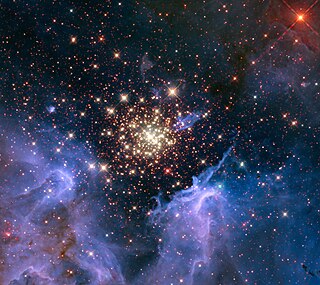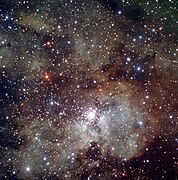| Revision as of 08:49, 14 September 2010 editGavin.collins (talk | contribs)18,503 edits Yohei Harayama; 'The IMF of the massive star-forming region NGC 3603 from NIR adaptive optics observations← Previous edit | Revision as of 00:41, 2 October 2010 edit undoUcucha (talk | contribs)Administrators38,569 edits remove copyright violationsNext edit → | ||
| Line 25: | Line 25: | ||
| }} | }} | ||
| '''NGC 3603''' is an ] of ]s situated in the ] spiral arm of the ] around 20,000 light-years away from the Solar System. |
'''NGC 3603''' is an ] of ]s situated in the ] spiral arm of the ] around 20,000 light-years away from the Solar System. | ||
| Owing to its uniqueness in terms of the intrinsic properties such as the proximity, relatively low ], extreme compactness and brightness, NGC 3603 is one of the best examples of a ] and since its discovery more than a century ago, NGC 3603 has been intensively studied<ref>Harayama,Yohei: ''The IMF of the massive star-forming region NGC 3603 from ] ] observations'', ], January 2007, </ref>. | |||
| It was observed by ] on the 14th of March ] during his ], who remarked that it was "a very remarkable object...perhaps a ]". Herschel catalogued it as ] 3334 in his ''Results of Astronomical Observations made at the Cape of Good Hope'', publshed in ]. In ] the ] published his '']'', where he listed it as number 2354. It was subsequently incorporated into the '']'' as by ] as NGC 3603.<ref name=Sher1965>{{cite journal | It was observed by ] on the 14th of March ] during his ], who remarked that it was "a very remarkable object...perhaps a ]". Herschel catalogued it as ] 3334 in his ''Results of Astronomical Observations made at the Cape of Good Hope'', publshed in ]. In ] the ] published his '']'', where he listed it as number 2354. It was subsequently incorporated into the '']'' as by ] as NGC 3603.<ref name=Sher1965>{{cite journal | ||
| Line 40: | Line 38: | ||
| Strong ultraviolet radiation and stellar winds have cleared the gas and dust, giving an unobscured view of the cluster<ref>http://hubblesite.org/newscenter/archive/releases/2010/22/image/a</ref>. | Strong ultraviolet radiation and stellar winds have cleared the gas and dust, giving an unobscured view of the cluster<ref>http://hubblesite.org/newscenter/archive/releases/2010/22/image/a</ref>. | ||
| Three prominent ] have been detected within the cluster<ref>C. G. De Pree, Melissa C. Nysewander, & W. M. Goss: ''NGC 3576 and NGC 3603: Two Luminous Southern H Ii Regions Observed At High Resolution With The Australia Telescope Compact Array'', ],], June 1999, Vol. 117, p.2916</ref>. |
Three prominent ] have been detected within the cluster<ref>C. G. De Pree, Melissa C. Nysewander, & W. M. Goss: ''NGC 3576 and NGC 3603: Two Luminous Southern H Ii Regions Observed At High Resolution With The Australia Telescope Compact Array'', ],], June 1999, Vol. 117, p.2916</ref>. | ||
| NGC 3603 is visible in the telescope as a small rather insignificant nebulosity with a yellowish tinge due to the effects of interstellar absorption. In the mid-1960s optical studies coincided with radio astronomical observations which showed it to be an extremely strong thermal radio source. Later observations in other galaxies introduced the concept of 'starburst' regions, in some cases whole galaxies, of extremely rapid star formation and NGC 3603 is now considered to be such a region. In 1987 a supernova (known as ]) occurred in the ]. This was the first supernova to be close enough for detailed observation with satellite based telescopes. One result was the discovery that prior to the main explosion it had thrown off a relatively small amount of material in a very distinctive pattern, a bit like an hourglass perpendicular to a detached glowing ring. One star in NGC 3603 (], the number comes from the 1960s optical observations) was found to have thrown off matter in a pattern similar to that found for the supernova 1987A. This coincidence has aroused intense interest. | NGC 3603 is visible in the telescope as a small rather insignificant nebulosity with a yellowish tinge due to the effects of interstellar absorption. In the mid-1960s optical studies coincided with radio astronomical observations which showed it to be an extremely strong thermal radio source. Later observations in other galaxies introduced the concept of 'starburst' regions, in some cases whole galaxies, of extremely rapid star formation and NGC 3603 is now considered to be such a region. In 1987 a supernova (known as ]) occurred in the ]. This was the first supernova to be close enough for detailed observation with satellite based telescopes. One result was the discovery that prior to the main explosion it had thrown off a relatively small amount of material in a very distinctive pattern, a bit like an hourglass perpendicular to a detached glowing ring. One star in NGC 3603 (], the number comes from the 1960s optical observations) was found to have thrown off matter in a pattern similar to that found for the supernova 1987A. This coincidence has aroused intense interest. | ||
Revision as of 00:41, 2 October 2010
 HST image of NGC 3603 HST image of NGC 3603 | |
| Object type | Open cluster, H II region, astronomical radio source |
|---|---|
| Observation data (Epoch J2000) | |
| Constellation | Carina |
| Right ascension | 11 15 09.1 |
| Declination | −61° 16′ 17″ |
| Distance | 20 kly / 6.1 kpc |
In visual light (V) | |
| Apparent magnitude | 9.1 |
| Size | 3′ |
| Mass | - M☉ |
| Radius | - |
| Estimated age | - |
| Notable features | Central region is the young cluster HD 97950 |
| [edit on Wikidata] | |
NGC 3603 is an open cluster of stars situated in the Carina spiral arm of the Milky Way around 20,000 light-years away from the Solar System.
It was observed by John Herschel on the 14th of March 1834 during his visit to South Africa, who remarked that it was "a very remarkable object...perhaps a globular cluster". Herschel catalogued it as nebula 3334 in his Results of Astronomical Observations made at the Cape of Good Hope, publshed in 1847. In 1864 the Royal Society published his General Catalogue of Nebulae and Clusters, where he listed it as number 2354. It was subsequently incorporated into the New General Catalogue as by J. L. E. Dreyer as NGC 3603..
Features
It is surrounded by the most massive visible cloud of glowing gas and plasma known as a H II region in the Milky Way. HD 97950 is the central star of star cluster, the densest concentration of very massive stars known in the galaxy. Strong ultraviolet radiation and stellar winds have cleared the gas and dust, giving an unobscured view of the cluster.
Three prominent Wolf-Rayet stars have been detected within the cluster.
NGC 3603 is visible in the telescope as a small rather insignificant nebulosity with a yellowish tinge due to the effects of interstellar absorption. In the mid-1960s optical studies coincided with radio astronomical observations which showed it to be an extremely strong thermal radio source. Later observations in other galaxies introduced the concept of 'starburst' regions, in some cases whole galaxies, of extremely rapid star formation and NGC 3603 is now considered to be such a region. In 1987 a supernova (known as SN 1987A) occurred in the Large Magellanic Cloud. This was the first supernova to be close enough for detailed observation with satellite based telescopes. One result was the discovery that prior to the main explosion it had thrown off a relatively small amount of material in a very distinctive pattern, a bit like an hourglass perpendicular to a detached glowing ring. One star in NGC 3603 (Sher 25, the number comes from the 1960s optical observations) was found to have thrown off matter in a pattern similar to that found for the supernova 1987A. This coincidence has aroused intense interest.
Gallery
-
 The core of the star cluster in NGC 3603 is shown in great detail in an image from the Wide Field Planetary Camera 2 (WFPC2) camera on the NASA/ESA Hubble Space Telescope.
The core of the star cluster in NGC 3603 is shown in great detail in an image from the Wide Field Planetary Camera 2 (WFPC2) camera on the NASA/ESA Hubble Space Telescope.
-
 Image of the NGC 3603 region were obtained in three near-IR filter bands (Js, H and Ks) with the ISAAC instrument at the ANTU telescope.
Image of the NGC 3603 region were obtained in three near-IR filter bands (Js, H and Ks) with the ISAAC instrument at the ANTU telescope.
-
 The image, obtained with the FORS instrument attached to one of the four 8.2-metre VLT Unit Telescopes at Cerro Paranal, Chile, is a three-colour combination of exposures acquired through visible and near-infrared (V, R, I) filters.
The image, obtained with the FORS instrument attached to one of the four 8.2-metre VLT Unit Telescopes at Cerro Paranal, Chile, is a three-colour combination of exposures acquired through visible and near-infrared (V, R, I) filters.
References
- ^ "SIMBAD Astronomical Database". Results for NGC 3603. Retrieved 2006-11-28.
- ^ "Star Cluster Bursts into Life in New Hubble Image - Fast Facts". Retrieved 2007-10-07.
- Sher, D. (1965). "The Curious History of NGC 3603". Journal of the Royal Astronomical Society of Canada. 59: 67–70. Retrieved 2010-09-08.
- B. Brandl, W. Brandner, E.K. Grebel AND H. Zinnecker: "VLT/ISAAC and HST/WFPC2 Observations of NGC 3603", (The Messenger, No. 98 – December 1999, European Organisation for Astronomical Research in the Southern Hemisphere, Garching, Germany)
- KH Hofmann, G Weigelt, W Seggewise: "Resolution and evolution of the core of the giant HII region NGC 3603"(Symposium-International Astronomical Union, 1995)
- Drissen, L., Moffat, A.F.J., Walborn, N.R. and Shara, M.M. The dense galactic starburst NGC 3603. I. HST/FOS spectroscopy of individual stars in the core (Astronomical Journal v.110, p.2235)
- http://hubblesite.org/newscenter/archive/releases/2010/22/image/a
- C. G. De Pree, Melissa C. Nysewander, & W. M. Goss: NGC 3576 and NGC 3603: Two Luminous Southern H Ii Regions Observed At High Resolution With The Australia Telescope Compact Array, Astronomical Journal,University of Chicago Press, June 1999, Vol. 117, p.2916
External links
- Hubble Space Telescope: Star Cluster Bursts into Life in New Hubble Image
- European Southern Observatory: The Stars behind the Curtain